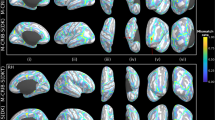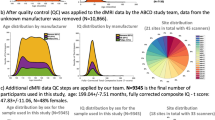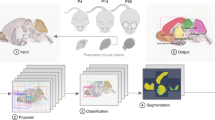Abstract
The human cerebral cortex undergoes dramatic and critical development during early postnatal stages. Benefiting from advances in neuroimaging, many infant brain magnetic resonance imaging (MRI) datasets have been collected from multiple imaging sites with different scanners and imaging protocols for the investigation of normal and abnormal early brain development. However, it is extremely challenging to precisely process and quantify infant brain development with these multisite imaging data because infant brain MRI scans exhibit (a) extremely low and dynamic tissue contrast caused by ongoing myelination and maturation and (b) inter-site data heterogeneity resulting from the use of diverse imaging protocols/scanners. Consequently, existing computational tools and pipelines typically perform poorly on infant MRI data. To address these challenges, we propose a robust, multisite-applicable, infant-tailored computational pipeline that leverages powerful deep learning techniques. The main functionality of the proposed pipeline includes preprocessing, brain skull stripping, tissue segmentation, topology correction, cortical surface reconstruction and measurement. Our pipeline can handle both T1w and T2w structural infant brain MR images well in a wide age range (from birth to 6 years of age) and is effective for different imaging protocols/scanners, despite being trained only on the data from the Baby Connectome Project. Extensive comparisons with existing methods on multisite, multimodal and multi-age datasets demonstrate superior effectiveness, accuracy and robustness of our pipeline. We have maintained a website, iBEAT Cloud, for users to process their images with our pipeline (http://www.ibeat.cloud), which has successfully processed over 16,000 infant MRI scans from more than 100 institutions with various imaging protocols/scanners.
This is a preview of subscription content, access via your institution
Access options
Access Nature and 54 other Nature Portfolio journals
Get Nature+, our best-value online-access subscription
$29.99 / 30 days
cancel any time
Subscribe to this journal
Receive 12 print issues and online access
$259.00 per year
only $21.58 per issue
Buy this article
- Purchase on Springer Link
- Instant access to full article PDF
Prices may be subject to local taxes which are calculated during checkout











Similar content being viewed by others
Data availability
To quantitatively validate our pipeline, we adopted three public datasets: the BCP dataset (https://nda.nih.gov/edit_collection.html?id=2848), the dHCP dataset (http://www.developingconnectome.org/data-release/second-data-release/) and a multisite multiscanner 6-month dataset, MSMS6 (https://iseg2019.web.unc.edu/data/). The software used in this protocol can be found at www.ibeat.cloud (iBEAT V2.0 Cloud) and iBEAT V2.0 Docker version (https://github.com/iBEAT-V2/iBEAT-V2.0-Docker).
References
Gilmore, J. H., Knickmeyer, R. C. & Gao, W. Imaging structural and functional brain development in early childhood. Nat. Rev. Neurosci. 19, 123–137 (2018).
Li, G. et al. Computational neuroanatomy of baby brains: a review. NeuroImage 185, 906–925 (2019).
Lyall, A. E. et al. Dynamic development of regional cortical thickness and surface area in early childhood. Cereb. Cortex 25, 2204–2212 (2015).
Garcia, K. E. et al. Dynamic patterns of cortical expansion during folding of the preterm human brain. Proc. Natl Acad. Sci. USA 115, 3156–3161 (2018).
Li, G. et al. Mapping longitudinal development of local cortical gyrification in infants from birth to 2 years of age. J. Neurosci. 34, 4228–4238 (2014).
Wang, F. et al. Developmental topography of cortical thickness during infancy. Proc. Natl Acad. Sci. USA 116, 15855–15860 (2019).
Shaw, P. et al. Intellectual ability and cortical development in children and adolescents. Nature 440, 676–679 (2006).
Howell, B. R. et al. The UNC/UMN Baby Connectome Project (BCP): an overview of the study design and protocol development. NeuroImage 185, 891–905 (2019).
Makropoulos, A. et al. The developing human connectome project: a minimal processing pipeline for neonatal cortical surface reconstruction. NeuroImage 173, 88–112 (2018).
Dale, A. M., Fischl, B. & Sereno, M. I. Cortical surface-based analysis: I. segmentation and surface reconstruction. NeuroImage 9, 179–194 (1999).
Fischl, B., Sereno, M. I. & Dale, A. M. Cortical surface-based analysis: II. inflation, flattening, and a surface-based coordinate system. NeuroImage 9, 195–207 (1999).
Hagler, D. J. et al. Image processing and analysis methods for the Adolescent Brain Cognitive Development Study. NeuroImage 202, 116091 (2019).
Glasser, M. F. et al. The minimal preprocessing pipelines for the Human Connectome Project. NeuroImage 80, 105–124 (2013).
Sun, Y. et al. Multi-site infant brain segmentation algorithms: the iSeg-2019 challenge. IEEE Trans. Med. Imaging 40, 1363–1376 (2021).
Ellis, C. T. et al. Retinotopic organization of visual cortex in human infants. Neuron 109, 2616–2626.e6 (2021).
Hu, D. et al. Existence of functional connectome fingerprint during infancy and its stability over months. J. Neurosci. 42, 377–389 (2022).
Na, X. et al. Maternal obesity during pregnancy is associated with lower cortical thickness in the neonate brain. Am. J. Neuroradiol. https://doi.org/10.3174/ajnr.a7316 (2021).
Wang, Y. et al. Developmental abnormalities of structural covariance networks of cortical thickness and surface area in autistic infants within the first 2 years. Cereb. Cortex https://doi.org/10.1093/cercor/bhab448 (2022).
Natu, V. S. et al. Infants’ cortex undergoes microstructural growth coupled with myelination during development. Commun. Biol. 4, 1–12 (2021).
Grotheer, M. et al. White matter myelination during early infancy is linked to spatial gradients and myelin content at birth. Nat. Commun. 13, 1–12 (2022).
Jiang, W. et al. Neural alterations in opioid-exposed infants revealed by edge-centric brain functional networks. Brain Commun. 4, (2022).
Huang, Y. et al. Mapping developmental regionalization and patterns of cortical surface area from 29 post-menstrual weeks to 2 years of age. Proc. Natl Acad. Sci. USA 119, e2121748119 (2022).
Sled, J. G., Zijdenbos, A. P. & Evans, A. C. A nonparametric method for automatic correction of intensity nonuniformity in mri data. IEEE Trans. Med. Imaging 17, 87–97 (1998).
Tustison, N. J. et al. N4ITK: improved N3 bias correction. IEEE Trans. Med. Imaging 29, 1310–1320 (2010).
Jenkinson, M. & Smith, S. A global optimisation method for robust affine registration of brain images. Med. Image Anal. 5, 143–156 (2001).
Jenkinson, M., Bannister, P., Brady, M. & Smith, S. Improved optimization for the robust and accurate linear registration and motion correction of brain images. NeuroImage 17, 825–841 (2002).
Sun, L. et al. Topological correction of infant white matter surfaces using anatomically constrained convolutional neural network. NeuroImage 198, 114–124 (2019).
Yeo, B. T. T. et al. Spherical demons: fast diffeomorphic landmark-free surface registration. IEEE Trans. Med. Imaging 29, 650–668 (2010).
Robinson, E. C. et al. MSM: a new flexible framework for multimodal surface matching. NeuroImage 100, 414–426 (2014).
Zhao, F. et al. Spherical deformable U-net: application to cortical surface parcellation and development prediction. IEEE Trans. Med. Imaging 40, 1217–1228 (2021).
Zhao, F. et al. S3Reg: superfast spherical surface registration based on deep learning. IEEE Trans. Med. Imaging https://doi.org/10.1109/TMI.2021.3069645 (2021).
Wang, L. et al. LINKS: Learning-based multi-source IntegratioN frameworK for Segmentation of infant brain images. NeuroImage 108, 160–172 (2015).
Zöllei, L., Iglesias, J. E., Ou, Y., Grant, P. E. & Fischl, B. Infant FreeSurfer: an automated segmentation and surface extraction pipeline for T1-weighted neuroimaging data of infants 0–2 years. NeuroImage 218, 116946 (2020).
Henschel, L. et al. FastSurfer—a fast and accurate deep learning based neuroimaging pipeline. NeuroImage 219, 117012 (2020).
Wang, L. et al. Benchmark on automatic six-month-old infant brain segmentation algorithms: the iSeg-2017 challenge. IEEE Trans. Med. Imaging 38, 2219–2230 (2019).
Zaitsev, M., Maclaren, J. & Herbst, M. Motion artifacts in MRI: a complex problem with many partial solutions. J. Magn. Reson. Imaging 42, 887–901 (2015).
Paschal, C. B. & Morris, H. D. K-space in the clinic. J. Magn. Reson. Imaging 19, 145–159 (2004).
Drakulich, S. et al. Maturational trajectories of pericortical contrast in typical brain development. NeuroImage 235, (2021).
Desikan, R. S. et al. An automated labeling system for subdividing the human cerebral cortex on MRI scans into gyral based regions of interest. NeuroImage 31, 968–980 (2006).
Wu, Z. et al. Construction of 4D infant cortical surface atlases with sharp folding patterns via spherical patch-based group-wise sparse representation. Hum. Brain Mapp. 40, 3860–3880 (2019).
Li, G. et al. Mapping region-specific longitudinal cortical surface expansion from birth to 2 years of age. Cereb. Cortex 23, 2724–2733 (2013).
Nie, J. et al. Longitudinal development of cortical thickness, folding, and fiber density networks in the first 2 years of life. Hum. Brain Mapp. 35, 3726–3737 (2014).
Li, G., Lin, W., Gilmore, J. H. & Shen, D. Spatial patterns, longitudinal development, and hemispheric asymmetries of cortical thickness in infants from birth to 2 years of age. J. Neurosci. 35, 9150–9162 (2015).
Acknowledgements
This work was partially supported by NIH grants (MH116225, MH117943, MH109773 and MH123202). This work also utilizes approaches developed by an NIH grant (1U01MH110274) and the efforts of the UNC/UMN Baby Connectome Project Consortium. The authors also thank D. Shen for an initial discussion of this work when he was with the University of North Carolina at Chapel Hill.
Author information
Authors and Affiliations
Contributions
L.W. and G.L. designed the pipeline framework. L.W., Z.W. and G.L. implemented the pipeline and performed the validation. Z.W., L.C. and Y.S. prepared the experimental results. L.W., Z.W., W.L. and G.L. wrote the paper.
Corresponding authors
Ethics declarations
Competing interests
The authors declare no competing interests.
Peer review
Peer review information
Nature Protocols thanks Jessica Dubois and Natasha Leporé for their contribution to the peer review of this work.
Additional information
Publisher’s note Springer Nature remains neutral with regard to jurisdictional claims in published maps and institutional affiliations.
Related links
Key references using this protocol
Ellis, C. T. et al. Neuron 109, 2616–2626.e6 (2021): https://doi.org/10.1016/j.neuron.2021.06.004
Natu, V. S. et al. Commun. Biol. 4, 1191 (2021): https://doi.org/10.1038/s42003-021-02706-w
Grotheer, M. et al. Nat. Commun. 13, 997 (2022): https://doi.org/10.1038/s41467-022-28326-4
Huang, Y. et al. Proc. Natl Acad. Sci. USA 119, e2121748119 (2022): https://doi.org/10.1073/pnas.2121748119
Extended data
Extended Data Fig. 1 Comparison of processing results between Infant FreeSurfer and iBEAT V2.0 on different datasets.
i. Comparison on the BCP dataset. ii. Comparison on the dHCP dataset. iii. Comparison on the MSMS dataset. (a) T1w images. (b) Tissue segmentation by Infant FreeSurfer. (c) Tissue segmentation by iBEAT V2.0. (d) iBEAT V2.0 reconstructed cortical surfaces overlayed on intensity images, with red contours indicating inner surfaces and green contours indicating outer surfaces. (e) Reconstructed inner cortical surface using Infant FreeSurfer. (f) Reconstructed inner cortical surfaces using iBEAT V2.0. (g) Reconstructed outer cortical surfaces (color-coded by cortical thickness) using iBEAT V2.0.
Extended Data Fig. 2 Comparison between dHCP released results and iBEAT V2.0 processed results.
i. Comparison between the dHCP released results and the iBEAT V2.0 processed results on two randomly selected subjects in the dHCP dataset. i.(a) T2w images; i.(b) Gray matter and white matter tissue boundaries from iBEAT V2.0 segmentation (green) and the dHCP released segmentation (red); i.(c) Color-coded vertex-wise surface distance maps between iBEAT V2.0 reconstructed inner surfaces and dHCP inner surfaces; i.(d) Color-coded vertex-wise surface distance maps between our reconstructed outer surfaces and dHCP outer surfaces; i.(e) Close-up views of our reconstructed inner and outer surfaces in i.(c) and i.(d); i.(f) Close-up views of the dHCP released inner and outer surfaces in i.(c) and i.(d). ii. Quantitative comparison between iBEAT V2.0 results and the dHCP released results. ii.(a) The Dice ratio of the gray matter and white matter; ii.(b) The average surface distance (ASD, mm) of the gray matter and white matter. iii. Comparison of the reconstructed cortical surfaces (colored-coded by mean curvature) in the occipital lobe of a typical subject using the dHCP pipeline and iBEAT V2.0 pipeline. iii.(a) The posterior view. iii.(b) The medial view of the left hemisphere. iii. (c) The medial view of the right hemisphere.
Extended Data Fig. 3 Comparison of the processed results using the FastSurfer pipeline and iBEAT V2.0 pipeline on different subjects (of different ages) from the BCP dataset.
(a). T1w images. (b) FastSurfer processed results. (c) iBEAT V2.0 processed results. The green contours in the figure indicate gray matter boundaries, and the red contours indicate white matter boundaries. Since FastSurfer is mainly developed for adult brains, two comparison pipelines achieved comparable results for the 60-month-old subject.
Extended Data Fig. 4 Quantitative evaluation of different methods on datasets from different scanners/protocols.
(a) The gray matter segmentation evaluation. (b) The white matter segmentation evaluation. The Dice ratio and Average Surface Distance (ASD, mm) evaluation metrics are reported for each evaluation. The error bars denote the standard deviation of the evaluation metric using different methods on the testing subjects.
Extended Data Fig. 5 Comparison of segmentation results by typical pipelines for 5 images from the BCP dataset with and without motion artifacts.
(a) Results for images without motion artifacts. (b) Results for images with motion artifacts. (c) Difference maps of the segmentation results with and without motion artifacts. Since IFS, volBrain, FreeSurfer, and FastSurfer mainly use T1w images as input, we also only used T1w images for a fair comparison.
Extended Data Fig. 6 Typical reconstructed cortical surfaces with different levels of quality.
Illustration of the different quality levels of reconstructed cortical surfaces. The first row shows the typical surfaces that are categorized as poor quality. These surfaces have large gyri or sulci missing, causing wrong geometry and/or wrong topology. The second row shows the surfaces with fair quality. They are generally accurately reconstructed in most brain regions, with tiny gyri/sulci missing. The third row shows the good surfaces with accurately reconstructed gyri and sulci.
Supplementary information
Supplementary Information
Supplementary methods, results and Figs. 1–8.
Rights and permissions
Springer Nature or its licensor (e.g. a society or other partner) holds exclusive rights to this article under a publishing agreement with the author(s) or other rightsholder(s); author self-archiving of the accepted manuscript version of this article is solely governed by the terms of such publishing agreement and applicable law.
About this article
Cite this article
Wang, L., Wu, Z., Chen, L. et al. iBEAT V2.0: a multisite-applicable, deep learning-based pipeline for infant cerebral cortical surface reconstruction. Nat Protoc 18, 1488–1509 (2023). https://doi.org/10.1038/s41596-023-00806-x
Received:
Accepted:
Published:
Issue Date:
DOI: https://doi.org/10.1038/s41596-023-00806-x
This article is cited by
-
Automated neonatal nnU-Net brain MRI extractor trained on a large multi-institutional dataset
Scientific Reports (2024)
-
Deep learning-based, fully automated, pediatric brain segmentation
Scientific Reports (2024)
-
Self-supervised learning with application for infant cerebellum segmentation and analysis
Nature Communications (2023)
-
Four-dimensional mapping of dynamic longitudinal brain subcortical development and early learning functions in infants
Nature Communications (2023)
Comments
By submitting a comment you agree to abide by our Terms and Community Guidelines. If you find something abusive or that does not comply with our terms or guidelines please flag it as inappropriate.



